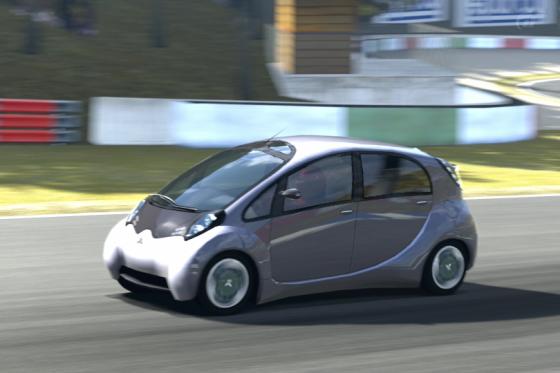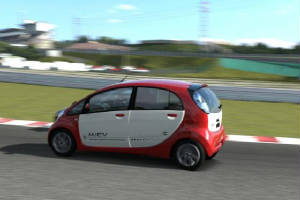|
Years represented: 2003-2010
Hosts: GT4, GT5
Country of Origin: Japan
Class: Kei
Type: 5-Door Hatchback
Price:
Prize from Mirage Cup (i Concept, GT4)
`````````$34.994 (i Concept, used car lot,
GT5)
`````````$46,000 (i-MiEV, Premium car lot)
Construction: aluminum monocoque
i Concept specs
Length: 138.4 " // Width: 59.25" // Height: 59.6"
Wheelbase: 100.8"
Overhang:
3 feet 2 inches
Track: 51.2" [F], 50.4 [R]
Ground Clearance:
Weight: 1,742 pounds
Layout: rear-mid engine
/ rear-drive
Tires:
F. Suspension: Macpherson struts, coils
R. Suspension: DeDion Axle, shocks, Watt's links, coils
Brakes:
?
ABS? Yes /// EBD? Yes
Engine: 999 cc DOHC inline-3
Construction: aluminum block
& head
Aspiration: natural with "dual VVT" valvetrain
Fuel System: EFi
Valves / Cyl: 4
Bore x Stoke:
Compression:
Tested
HP: 66 @ 6,000 rpm
Tstd. Trque: 67 @ 3,500 rpm
Credits per HP: $530.21
Pounds per HP: 26.39
Pounds
per Tq: 26.00
HP per Liter: 66.6
Idle: 650 // Redline: 6,250 // RPM Limit:
Transmission: CVT
Differential:
open
0-60 mph:
0-100 mph:
0-150 mph:
400 M:
1 Kilom:
Top Speed at Redline:
i-MiEV specs
Length:
133.66" // Width: 58.1" // Height: 100.4"
Wheelbase: 100.4"
Overhang: 2 feet 9 inches
Track:
Ground Clearance:
Weight: 2,425 pounds
Layout: rear motors / rear-drive
Tires: 145/ 65-15 [F], 175/55-15 [R]
F. suspension:
MacPherson struts, coils
R. suspension: 3-link, DeDion tube, Watt's Links, coils
Brakes:
Motor:
330 volt, 16 kWa permanent magnet-type
Construction:
Aspiration: 88 cell lithium-ion battery
Range (real-life):
80-100 miles
Tested HP: 61 @ 4,200 rpm
Tstd. Trq: 129 @ 1,000 rpm
Credits per HP: $754.01
Pounds
per HP: 39.76
Pounds per Trq: 18.80
Hp per Liter: ---
Transmission: none (direct drive motors at rear wheels)
Differential:
none
0-60 mph: 15.483
0-100 mph: nil
0-150 mph: nil
400 M: 22.258 / MPH NA
1 Kilom: 39.614 @ 82 mph
1 Mile: 55.890 @ 83 mph
Daytona Lap: 1:26.926
Top
Speed at Redline
83 mph @ 6,300 rpm (RPM limited)

---------EXTERIOR / HISTORY-----------
The Mitsubishi i. Those of you pondering which would be my very first Gran Turismo 5 car review, here
it is.
By the time I drove the Mitsubishi i (its gas-powered and electric versions), I had already driven several
others in GT5...a Fiat 500 1.2 Lounge, a VW New Beetle 2.0, '88 Honda Accord Coupe and a few others. But the i takes
the honorary first GT5 review. Somehow, reviewing the i just seems like the right way to start.
I'm sure I'm
like many others out there in this way: That first month of GT5 was a blur. A big, FAT blur, actually.
Lots of racing, lots of driving, lots of online competing. Race after race, grind after grind. Only now, on January 16,
2010, am I beginning to slow this frantic pace and finally getting the first review done.
The Mitsubishi i first appeared in GT4 as the '03 Concept where I conveniently ignored it over the
course of three years, maybe because in this game it was a prize. I wasn't in the habit of stalking those 1-make events as
actively as I had been in GT2 (who has time?). In GT5, the Concept stands out more forcefully, saying "pick me!
pick me!" as it boldly shows up in this game's used car lot. Since it appears early during the used car lot cycle, the
i Concept was one of my earliest choices to start the game.
One of the features of Gran Turismo 5 is PD has finally
brought the car descriptions back. Each car, once again, has its own little description to read as we're deciding whether
or not to purchase. We can even read this description while the game shows us a demo run!
So when Mitsubishi decided to name this the "i" part, this had nothing to do with Apple products, nor
is it some sort of association between Mitsubishi and Apple, as I'm sure many have assumed (myself included). The "i"
is actually in reference to the Japanese word for love, which is phonetically spelled "aye" when using the English
alphabet. "Mitsubishi aye" would be weird, though.
The i-MiEV is what is called a "plug-in
electric", which means it needs several hours to recharge via an electrical outlet. It is also a Kei car,
which means it's a subcompact. Weird, huh? It looks bigger than it actually is, somehow, but its dimensions are within
Japan's infamous Kei car designations. The i Concept, on the other hand, is too big for the Kei class I believe. The
Mitsubishi i is also a mid-engine / rear-drive car (assuming we're talking of the gas-powered
version) or rear-motored / rear-drive (MiEV electric version).
It's interesting that the i Concept
weighs several hundred pounds lighter than the MiEV. Granted, it is a concept, and concepts are sometimes incomplete vehicles.
The MiEV's battery pack also weighs somewhere around 200 kg (440 pounds), which is probably heavier than the Concept's 1.0
liter engine. Probably. I'm not entirely sure....I couldn't find much info on this powerplant. I did at some
point fully lighten the electric car so it could better compete in some K-car Seasonal Events. It falls to 2,063 pounds.
Despite
looking tallish, the i (gas or electric) also has a relatively low center of gravity. Driving it around, i was a
little surprised at its well-planted cornering capabilities. Perhaps the car's "all-wheelbase" stance has something to do
with this, as there is very little overhang to snag onto curbs with.
----------ENGINE / DRIVETRAIN-----------
We're talking about two different worlds here: of these cars is deathly silent, the other is a little buzz-bomb!
One of them is as stealthy as a hobbit with a silence spell cast upon it, the other, as loud as a drunken ogre who's
just raided a treasure chest.
Such are the differences between the i-MiEV and i Concept. Both cars have such different
personalities, it's as if they're twins trying desperately to hide the fact they're twins. One is bookwormish, smart,
and quietly promises great things for the future, while the other is a little pugnacious loudmouth.
In that scenario
above, the i Concept was the noisier of the two. The buzz bomb. Notice its revs stay at a constant 6,000 to 6,500 rpm at
all times. This is where peak power lies, depending on modifications. Its revs are kept constant because this car has
a CVT (Continuously {or Constant} Variable Transmission). And the interesting thing is; yes, this car is low-powered,
but that CVT at least keeps the 1.0 liter 3-cylinder engine in its peak power area at all times, giving it an advantage
over some other mousetraps. Others are actually losing small amounts of speed as they're shifting gears, as they
end up below their peak power over and over.
The i-MiEV, on the other hand, takes this transmission oddity a step
further. Matter of fact, the i-MiEV has no transmission. Instead, its mid-mounted motor is linked directly to the
rear axles. This is good and bad. Good because there is no power being soaked up by a set of extra gears, transmission fluid,
filter, and clutch. Bad because this car (unlike the Concept) will run out of revs eventually. Matter of fact,
this electrobox's top speed is in the low 80s.
So far as upgrades go, the i-MiEV is kinda like the '97 Toyota
Prius of GT2, which could not accept power upgrades. The i-MiEV, on the other hand can accept better suspension
parts, tires, weight reductions, and a limited-slip (which some drivers might actually want to consider purchasing). But
no extra power. Because of this, many might assume this egg should go no further than the dealer's podium.
The
surprsing thing, though, is that the i-MiEV can win a few of GT5's beginning races. So far I'm up to: Sunday Cup,
World Compact Car Series, and Lightweight K Cup. Grind all these races, and there is a decent profit, assuming all those
prizes get sold.
Battery packs wear out quickly during races, but since the MiEV can also regenerate its own power
during coasting and braking, I did try a little experiment; driving the i-MiEV around a 40 lap Arcade race at Autumn
Ring Mini. Would the i-MiEV run out of "juice"? Turns out, it unfortunately did, even though I tried to spend as much time
as possible coasting down Autumn Ring Mini's down hill area. Despite this, the battery actually did wear itself down to its
last bar, and then guess what happens? The car barely moves! A pull into the pits will not magically solve this.
Something to consider. This is not a vehicle of choice unless we're talking sprint trysts only.
----------CHASSIS / HANDLING------------
So the penultimate question: "Why is this car in my game? Why did they waste premium disc space
on an electric car?" Matter of fact, there is quite a good reason. These are actually great beginner's
cars to learn the art of mid-engine/rear-drive. Certainly better than a Honda Beat or Mazda AZ-1. That's the
conclusion I've made after driving both Mitsubishi i autos around several race tracks.
This is not just my opinion, this
is a fact. The i cars (electric and gasoline-powered) both can suffer from a lot of the same malaises as those of much higher-horsepower
MRs, yet have a stability that's not present with other miniature Kei cars. There's a reason why one of the current Seasonal
events in GT5 happens to be based on driving an i-MiEV around Deep Forest, it's because these cars can actually be challenging
to drive.
The only difference, of course, between an i and an NSX, an MR2, or a Lotus Elise is
in an i, there's zero possibility of reaching even 90 mph. Therefore, any difficulties faced driving an i (and there WILL
be some handling difficulties, amazingly) are easier to catch, since the i is always going slower than typical mid-engine
vehicles, which tend to be 2-seater sports cars.
In an i, there's still an MR vehicle's habit of snap oversteer (caused by entering corners too hot,
and then getting into too much of a slide). There's also throttle-driven oversteer,
even with such a lack of horsepower. There's the nervously light steering we often find in lighter cars like
the Toyota MR2, Tommykairas, and Elises.
The front-end also mildly understeers on entry sometimes. The i's front tires
are smaller than the rears (an effort to make the car's rear tires have better traction, since these cars are rear-drive)
which means they're prone to overheating while cornering somewhat hard. The Mitsubishi i is even prone to a
few spins if the driver is not concentrating hard enough.
All of this is caused by that mid-engine (or motor)
rear-drive layout. It's an unusual layout for a subcompact in this day and age, right? Most keis (or subcompacts) are front-drive...sometimes
all-wheel drive. For whatever reason, Mitsubishi's choice of MR could be the most practical solution.
So
the i is tricky. Granted, it's easier to see all this behavior if the car is on cheap tires, but it's interesting that
the i is not the boring, sleepy ride I'd been thinking it would be. I seriously thought I'd drive both versions of the
i for a few Sunday Cup races, and that would be it. Instead, these cars captured my imagination. Not because of their odd
gearing arrangements (or lack thereof), and not because one of them is electric, but because they are actually interesting
to drive.

PROS---------------------------------
1). Those who like goofballs
might want to add the i to their collection.
2). Fun to watch. The i's spacious glass windows also
allow us to watch our little driver steer and move around during B-spec and our very own replays, a new feature of GT5.
Very cool for sure.
3). The Concept is not much different from the MiEV (so far as looks and presentation goes),
which means Mitsubishi managed to take this car from "concept" to reality with only the smallest of visual changes. My point:
yes this car is goofy as hell, but Mitsubishi did not compromise its looks once it was in production. Laugh all you want,
but this dedication keeps the automotive market fresh.
4). Yes, they're mid-engine/rear-drive, and yes they oversteer
(in GT5 anyways). Challenging and fun to drive. Driftable, even.
5). From the Sunday Cup to the World Compact races.
From the Lightweight K Cup to some current Seasonal events, the Mitsubishi i twins have a surprisingly longer repertoire
of possible wins than I'd first assumed. This is truer of the i Concept driven during A-spec, of course, since the Concept
can accept several small power upgrades.
6). The i-MiEV is also a Premium car, which means we get to be fascinated
by its instrumentation arrangements.
7). Driving along in the i-MiEV as its motors run quietly behind is
neat.
8). Perfect mid-engine (or motor) rear-drives for beginners.
CONS---------------------------------
1). Slow....at all times.
2). Somewhat costly for a couple of novelties that won't have very long careers.
3). Limited
power upgrades for the Concept. And the i-MiEV has no actual power-ups.
4). Ugly, somewhat useless cars,
in some opinions.
5). i-MiEV has no trasmission (or tranny upgrades) which means it eventually maxes out of revs down
many straight sections.
6). i-MiEV can also run out of battery power after just a few laps. This power
does NOT get replenished during pit stops.
7). i Concept: loud.
8). i Concept: also a used car in
GT5, which means it's incredibly hard to find for those who want to hunt one down.
9). Tricky handling traits. Both
cars are prone to some serious handling issues at times, despite the slowness. Those front tires are much smaller than the
rears, and have a habit of losing grip (flaring red-hot) during hard cornering.
10). Somewhat expensive
cars, considering many autos of their subcompact class are so much cheaper. The i twins probably won't ultimately
get much track time from most gamers, despite their priceyness.
Written & published: January
16, 2011-February 9, 2011
Edited of overly-exasperated content October 2, 2019
|
